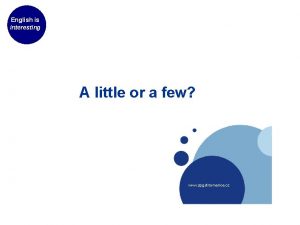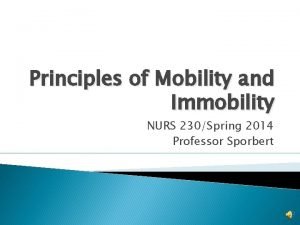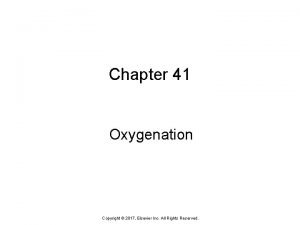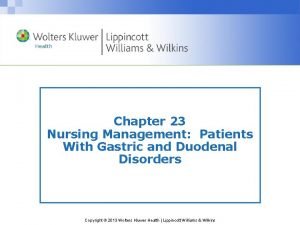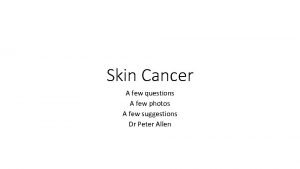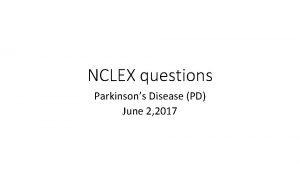A few NCLEX questionsall 7 questions are from







- Slides: 7

A few NCLEX questions-all 7 questions are from Mosby’s Comprehensive Review of Nursing for the NCLEX-RN examination- 20 th edition - by Nugent et al. Page 730 -Q 272 -The school nurse is planning to teach a class about nutrition. Which age group will be most receptive to this information? a) 6 year old children b) 8 year old children c) 11 year old children d) 15 year old children a) 6 year old children-6 year old children are just beginning to experience the developmental goals of the school-age child. They are not ready to make choices based on what they have learned. b) 8 year old children- 8 year old children are beginning to achieve a sense of industry and accomplishment. They are in Piaget’s stage of concrete operations wherein they are able to use their thought processes to experience actions. Their growing independence enables them to make decisions based on what they have learned. c) 11 year old children-pre-adolescents are beginning to assert their independence and probably will rebel if taught what they should eat d) 15 year old children-adolescents need to conform to their peer group. What is learned in nutrition class will be ignored in favour of pre-established preferences 1

Page 730 -Q 273 -Obesity in children is an ever increasing problem. What should a nurse consider before confronting the problem with individual children? a) enjoyment of specific foods is inherited b) childhood obesity is not usually a predictor of adult obesity c) children with obese parents and siblings are destined for obesity d) familial and cultural influences are deciding factors in eating habits a) enjoyment of specific foods is inherited-inheritance is not known to influence eating habits although it is believed that there may be hereditary factors associated with obesity b) childhood obesity is not usually a predictor of adult obesity-childhood obesity is a known predictor of adult obesity c) children with obese parents and siblings are destined for obesity-although there is a trend toward this, with intervention it can be prevented d) familial and cultural influences ae deciding factors in eating habits-studies have shown that culture and family eating habits have an impact on the child’s eating habits 2

Page 730 -Q 274 -An 11 year old child has gained weight. The mother tells a nurse that she is concerned that her child, who loves sports, may become obese. What is the nurse’s most appropriate response? a) Suggest an increase in activity b) Encourage a decreased caloric intake c) Explain that this is expected in pre-adolescence d) Discuss the influence of genetics on weight gain a) Suggest an increase in activity- before advising increased activity, the nurse should assess the child’s present level of activity b) Encourage a decreased caloric intake-an adequate caloric intake is needed for the growth spurt that will occur during adolescence c) Explain that this is expected in pre-adolescence-there may be a weight gain caused by the influence of hormones before the growth spurt. Most 10 - to 12 -year children can eat an adult-size meal without becoming obese, especially if they are active. d) Discuss the influence of genetics on weight gain-family eating patterns appear to have more effect on weight that do 3 genetics

Page 273 -Q 163 -A nurse is caring for a group of clients on a medical surgical unit. Which client has the highest risk for developing a pulmonary embolism? a) Obese client with leg trauma b) Pregnant client with acute asthma c) Client with diabetes who has cholecystitis d) Client with pneumonia who is immunodeficient a) Obese client with leg trauma- this person has two risk factors for the development of pulmonary embolism; obesity and leg trauma b) Pregnant client with acute asthma-only one risk factor (pregnancy) for pulmonary embolism c) Client with diabetes who has cholecystitis-only diabetes is a risk factor for pulmonary embolism d) Client with pneumonia who is immunodeficient-no risk factor for pulmonary embolism 4

Page 278 -Q 245 -Which statement by a client scheduled for bariatric surgery indicates to the nurse that further perioperative teaching is necessary? a) I need to eat more high protein foods b) I am going to have a figure like a model in a year c) I am going to be out of bed and sitting in a chair the first day after surgery d) I will be limiting my intake to 600 to 800 calories a day once I start eating a) I need to eat more high protein foods-the client needs to increase protein intake and avoid foods high in sugar and fat; alcohol and sweetened fluids should be avoided b) I am going to have a figure like a model in a year-clients need to be prepared emotionally for body image changes that occur after bariatric surgery. Clients generally experience excessive abdominal skin folds after weight stabilises which may require a panniculectomy. Body image disturbance often occurs in response to incorrectly estimating one’s size- it is not uncommon for the client to still feel fat no matter how much weight is lost c) I am going to be out of bed and sitting in a chair the first day after surgery—barring complications, clients are ambulated and transferred to a chair within 8 hours of surgery d) I will be limiting my intake to 600 to 800 calories a day once I start eating-six small feedings for a total of 600 to 800 calories in 24 hours plus fluids to prevent dehydration are routine once the healthcare provider orders a regular diet 5

Page 278 -Q 246 -A nurse is preparing a morbidly obese client for gastric bypass surgery. What should the nurse teach the client to do after surgery? a) Take medications in liquid form b) Lie on right side for 1 hour after meals c) Consume a high carbohydrate diet once eating is resumed d) Receive patient controlled analgesia for 6 days after surgery a) Take medications in liquid form-this allows for easier digestion and absorption of medications in the stomach b) Lie on right side for 1 hour after meals-this client should lie on the left side for 20 -30 minutes to delay gastric emptying c) Consume a high carbohydrate diet once eating is resumed-this client should be consuming a high protein diet with limited carbohydrates and no simple sugars; this will help minimise the dumping syndrome d) Receive patient controlled analgesia for 6 days after surgery-barring any complications, this client should be discharged in five days and will not need patient-controlled analgesia 6

Page 716 -Q 84 -A nurse plans to discuss childhood nutrition with a group of parents whose children have Down syndrome in an attempt to minimise a common nutritional problem. What problem should be addressed? a) rickets b) obesity c) anemia d) rumination a) rickets-this is a nutritional disorder related to vitamin D deficiency b) obesity-obesity is common nutritional problem of children with Down syndrome. It is thought to be related to excessive caloric intake and impaired growth c) anemia-this is the most common nutritional problem in children with an iron deficiency d) rumination-this is an eating disorder in infancy characterised by repeated regurgitation without a 7 gastrointestinal illness
